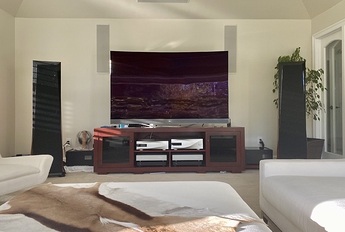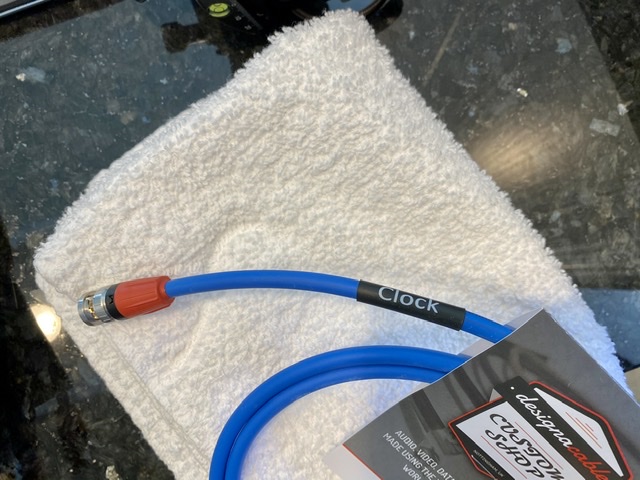[Apologies in advance for the long-winded post.]
I am a relatively recent convert to the dCS fold. My top-end DAC in my headphone rack is the MSB Select II DAC. I also own a Lumin A1 and a PS Audio DirectStream, and some less noteworthy boxes. The DirectStream was the DAC in my speaker system, until I went to audition a Bartok and Rossini at Music Lovers Audio in Bezerkeley. The DirectStream is a very nice DAC, that I think punches well above its price class. I had been very happy with it (even compared to the MSB upstairs, because I never entertained the notion that my speaker system could/should/would be as resolving as my headphone system, and my headphone rack was all about detail resolution); happy at least until I heard dCS. At my dealer, I auditioned the dCS equipment exclusively using my Hifiman Susvara and RAAL|Requisite SR1a headphones. I was impressed. And I was further impressed by the effect of the Rossini Clock on both Bartok and the Rossini DAC. In candor, I was amazed. The Clock made everything seem to snap more into focus. I could have blissfully listened to either Bartok or Rossini without the Clock, until I heard them with the Clock. Going back was not an acceptable option as far as I was concerned. And trying each without the Clock was the sure-fire way to prove it. From my perspective, the Clock did not improve bass or expand the soundstage or make any one instrument clearer or another less sibilant. Or any of that audiophile checklist stuff. It was more of an impact over the wholeness of the musical presentation, akin to going from Ektachrome 400 to Kodachrome 25 (or, in the digital world, going from a hi-res full frame sensor to a hi-res medium format one like the Phase One or even the Hasselblad). It just seemed more real . [And recall that this was on the SE1a ribbon earfield monitors; the best is yet to come.]
I will confess that the cynic in me thought: “Wait, they couldn’t build this better clock in? I have to buy a separate box?” My MSB has the Femto 33 clock module. Of course it costs extra, but it’s built in. I don’t mind dCS making a buck, but I sure wish the DAC could be configured with the super-clock built in to cut down on the number of boxes. Ah well, maybe in the Chopin or Mahler line, whenever it comes out. 
Anyway, after hearing the Rossini+Clock, Bartok went out the window (though it is still on the list as a separate headphone station in the bedroom). After talking with my dealer about the Vivaldi and Rossini product life cycles, we concluded—to his delight—that Vivaldi would get me more of what I wanted right now while still protecting my investment with fair trade-in/up policies. So, I ordered the DAC and Upsampler, since I needed network functionality (extra box grrr), and figured I would wait to get the Clock. And off I went to Tanzania for a few weeks of safari, and then unanticipated quarantine on return. My Vivaldi DAC and Upsampler arrived just before I came out of quarantine and right after the Bay Area got its first shelter-in-place order. So my dealer shipped them to me. And I made the decision to go ahead and order the Clock. The dCS factory had just shut down temporarily due to the coronavirus, but as it turned out, there was a silver Clock in stock at dCS North America.
Prior to Vivaldi, I was using the DirectStream DAC (with Network Bridge II) to feed the PS Audio BHK preamp and BHK 300 monoblocks into the Legacy Audio Aeris speakers. Not a bad sound at all, thoroughly enjoyable. But not be all, end all ; that’s what the headphone rack was for. Vivaldi was all about putting my speaker system on the same level as my headphone rack. And did it ever. Right out of the box, with no burn/brain-in, Vivaldi was a revelation compared to the DirectStream. Something about listening to Vivaldi prompted me to swap the BHK monoblocks out for the Merrill Audio Veritas monoblocks that preceded them, and were boxed up waiting to be sold or traded in. Wow. Merrill Audio’s “signature” is speed. His amps were the ones that stripped my Class D bias away, and all for the better. And the Vivaldi just sang through them. So much so that I decided to remove the BHK preamp. After some work to get the levels matched with the Aeris Wavelet processor, the Vivaldi really came into its own at 6V. So, the full PS Audio kit is about to be put on the market, and I now have Merrill’s latest Element 116 monoblocks on order, along with a Townshend Allegri Reference passive pre.
In the meantime, Vivaldi Clock showed up about a week after I began seriously listening to the stack. Setup was reasonably simple. I connected the Clock using Geistnote cables (I have Van Damme cables en route right now, and will audition Shunyata eventually), and much like the demo of Bartok and Rossini, the difference was immediately apparent. As I posted elsewhere here, my wife noticed it right away. The sense of realism is almost palpable, especially at low levels, which has become something of a touchstone for me. I highly recommend demoing any dCS master clock; but when you do, put away your audiophile dictionary/checklist and just listen. I was so struck by the improvement, that I decided to re-calibrate the Aeris (which I had also done after Vivaldi arrived), and they showed an additional improvement.
While I was listening to Vivaldi and looking forward to Clock’s arrival, I had been reading clock reviews, from Mutec to CH Precision to Cybershaft to Stanford Research to Brandywine. I was convinced that further clock precision, especially short-term precision, might improve my sound further. I contacted four of the five (CHP did not seem the best path), and based on the online reviews and answers to several questions, I decided to pursue Mutec and Cybershaft. Mutec has a new special edition out, difficult to obtain here in the US, but it wasn’t my first choice anyway. Cybershaft was my first choice (and appeared to be so for other Vivaldi owners on line), and despite being referred to by one Mutec reviewer as “unobtanium,” I found Cybershaft’s proprietor Kenji Hasegawa very knowledgeable, patient, and easy to work with. Eleven days after I reached out to him, my OP21A and power supply were headed to California.
The Cybershaft clock arrived well and safely packaged, with a performance certification printout for the clock and excellent user manuals for both the clock and the power supply. Connection was simple. Vivaldi Clock locked on to the Cybershaft immediately. I left everything running for 48 hours before listening with any sort of critical ear. Kenji-san advised that the clock would reach 95+% capability within 2-3 days. And did it ever. The change in presentation was not as dramatic as adding Vivaldi Clock, but it was no less discernible. In this case, it was like going from Kodachrome 25 to 10.
The combination of all these pieces together is intoxicating. They are not necessary to enjoying the music; I can tap my toes and dance around to AirPods or boom boxes. After all, this is all about music, not equipment. But if one wants the best possible sound reproduction at home, and your front end is digital, then it seems to me the best thing you can do is invest in timing accuracy. This combination of Vivaldi stack plus Cybershaft clock, is an exceptionally pleasurable way to do that. Highly, highly recommended.





 Easily the latter!
Easily the latter!


